|
The
Last Salute: Civil and Military Funeral, 1921-1969
CHAPTER XXII
Ambassador of Botswana, Zachariah K. Matthews
Ambassador of Spain, Mariano de Yturralde
Ambassador of Malagasy, Louis Rakotomalala
Ambassador of Poland, Edward Drozniak
Departure Ceremonies
1962-1968
When foreign dignitaries have died while in the United States, honors
in keeping with their rank and national origin have been accorded them
by the U.S. government. On most occasions these honors have taken the
form of a departure ceremony when the body of the foreign official was
returned to his homeland for burial.
Between 1962 and 1968 four foreign officials, each the ambassador of
his country, died while stationed in the United States. Ambassador of
Spain Mariano de Yturralde died in March 1962, Ambassador of Poland
Edward Drozniak in November 1966, Ambassador of Botswana Zachariah K.
Matthews in May 1968, and Ambassador of Malagasy Louis Rakotomalala
in July 1968. All were in Washington at the time of their deaths, and
all were returned to their countries by plane from Andrews Air Force
Base.
The departure ceremony for the ambassador of Botswana on 14 May 1968
was arranged by Headquarters Command, US Air Force, and carried out
by Air Force troops. The troop formations included an honor cordon,
a body bearer team, a national color detail, and the personal flag bearers.
(Table 14) The body was escorted by Metropolitan and Armed Forces
Police from Washington to Andrews Air Force Base. When the cortege arrived,
the honor cordon, lining the way to the aircraft that would carry the
ambassador's body to Botswana, presented arms as the body bearers removed
the casket from the hearse. With the national color detail leading and
the personal flag bearers at the rear, the ambassador's casket was carried
through the honor cordon and put aboard the plane. This ceremony was
the simplest of the four.
Responsibility for arranging and conducting the other three departure
ceremonies was assigned by the Department of Defense to the Military
District of Wash-
[180]
TABLE 14-TROOP LIST, DEPARTURE CEREMONY
FOR AMBASSADOR OF
BOTSWANA ZACHARIAH K. MATTHEWS
|
Duty
|
US Army
|
US Marine
Corps
|
US Navy
|
US Air
Force
|
US Coast
Guard
|
Total
|
|
Offi-
cers
|
En-
listed
Men
|
Offi-
cers
|
En-
listed
Men
|
Offi-
cers
|
En-
listed
Men
|
Offi-
cers
|
En-
listed
Men
|
Offi-
cers
|
En-
listed
Men
|
Offi-
cers
|
En-
listed
Men
|
| Honor cordon |
|
|
|
|
|
|
1
|
18
|
|
|
1
|
18
|
| Color detail |
|
|
|
|
|
|
|
5
|
|
|
|
5
|
| Body bearers |
|
|
|
|
|
|
|
8
|
|
|
|
8
|
| Personal flag bearer |
|
|
|
|
|
|
|
3
|
|
|
|
3
|
| Total |
|
|
|
|
|
|
1
|
34
|
|
|
1
|
34
|
ington. The planning for all three was based on the portions of the
current policy directives outlining departure honors in State, Official,
and Special Military Funerals. The three ceremonies were not identical;
variations occurred in the number of troops involved and in the composition
and procedures of the ceremonies. But all of them resembled departure
ceremonies for high-ranking US civil and military officials, and each
one was distinguished by recognition of the nationality of the ambassador
being honored.
In the departure ceremony for Ambassador Mariano de Yturralde on 7 March
1962, a street cordon of 105 men lined both sides of the air base roadway
leading to the ceremonial area at Andrews Field. Half an hour before
the scheduled arrival of the ambassador's body from Washington, these
troops were spaced at tenstep intervals facing the street. Within
the ceremonial area, which was surrounded by a security cordon to keep
it clear, an honor cordon of eighteen men lined the way from the point
at which the hearse bearing the casket would stop to the aircraft itself.
Also on hand were a band, a color detail of three men with the flag
of Spain, and an eight-man body bearer team.
US Park Police escorted the cortege that took the casket of Ambassador
de Yturralde from Washington to the air base. Although members of the
Military District of Washington staff had coordinated this movement
with the police on 6 March, the police, for reasons not apparent, completed
the move twenty minutes ahead of schedule. Air police at the gate, although
they had been informed of the schedule of events, sustained the error
in timing when they expedited rather than delayed the movement of the
cortege from the base gate to the ceremonial site. Maj. Gen. Paul A.
Gavan, commanding the Military District of Washington, fortunately had
passed the cortege on his way to the air base. Realizing that it was
ahead of schedule, he sped to the site of the ceremony to warn the troops.
Thus the confusion that might have been caused by the early arrival
of the cortege was averted. But as a result of the incident, Armed Forces
Police were put in the police
[181]
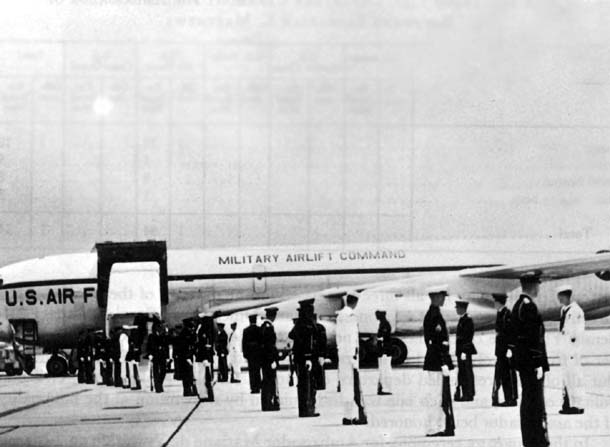
HONOR CORDON FORMS FOR AMBASSADOR RAKOTOMALALA
escort in all subsequent ceremonies of this kind, and a communications
vehicle was placed in the ceremonial area so that constant contact between
the motorcade and the ceremonial troops could be maintained.
As the cortege moved toward the ceremonial site, the members of the
street cordon presented arms individually without command as the lead
vehicle of the police escort approached and ordered arms when the hearse
had passed. In the ceremonial area, once the hearse had been parked
in the proper position the site control officer directed the body bearers
to move to the rear of the hearse. The honor cordon then presented arms
and the band played the national anthem of Spain, the national anthem
of the United States, and a hymn. As the hymn began, the body bearers
took the casket from the hearse. With the color detail leading, the
casket was carried through the honor cordon and taken aboard the aircraft.
Once it was aboard, the band ceased playing and the honor cordon ordered
arms, concluding the departure ceremony for Ambassador de Yturralde.
A ceremony quite similar to the one performed for the Ambassador of
Spain was conducted at Andrews Field on 6 July 1968 when the body of
Ambassador Louis Rakotomalala was returned to his African homeland,
the Republic of Mala-
[182]
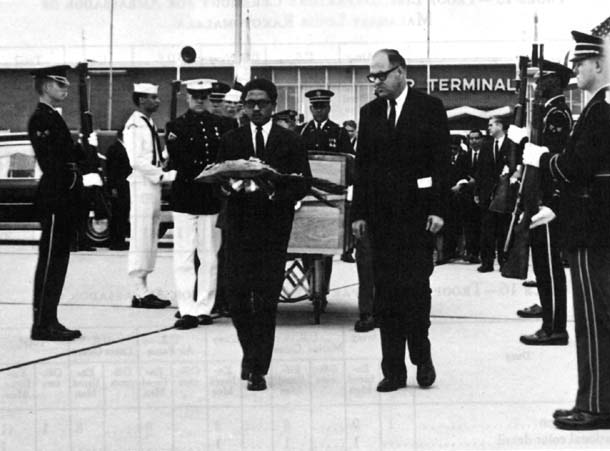
CASKET OF AMBASSADOR RAKOTOMALALA IS CARRIED TO AIRCRAFT
gasy. The main difference between the two ceremonies was in the troops
participating. No street cordon was employed in the ceremony for the
African official, but the honor cordon, a joint service group, was three
times the size of the cordon for the Spanish ambassador. Further, the
national colors of the United States and the Republic of Malagasy led
the way as a joint service body bearer team took Ambassador Rakotomalala's
casket through the honor cordon to the aircraft. Since the casket was
unusually cumbersome, it was supported by a movable bier. (Table
15)
Of the four ceremonies, the most elaborate took place on 3 November
1966 at the departure of the body of Ambassador Edward Drozniak of Poland.
The ceremony was unusual in that it took place at night.
Troops participating included the US Army Band, a joint service honor
cordon, a joint service body bearer team, a joint service color detail,
and the 3d Infantry saluting battery, a total of four officers and 121
men. Supporting troops consisted of a security cordon, press cordon,
parking detail, baggage detail, and Armed Forces Police in three radio
vehicles. (Table 16) All troops were in their respective positions
at 2125.
[183]
TABLE 15-TROOP LIST, DEPARTURE CEREMONY
FOR AMBASSADOR OF
MALAGASY LOUIS RAKOTOMALALA
|
Duty
|
US Army
|
US Marine
Corps
|
US Navy
|
US Air
Force
|
US Coast
Guard
|
Total
|
|
Offi-
cers
|
En-
listed
Men
|
Offi-
cers
|
En-
listed
Men
|
Offi-
cers
|
En-
listed
Men
|
Offi-
cers
|
En-
listed
Men
|
Offi-
cers
|
En-
listed
Men
|
Offi-
cers
|
En-
listed
Men
|
| Honor cordon |
|
15
|
|
10
|
|
10
|
|
12
|
|
8
|
|
55
|
| Color detail |
|
4
|
|
2
|
|
|
|
|
|
|
|
6
|
| Body bearers |
|
2
|
|
2
|
|
2
|
|
1
|
|
1
|
|
8
|
| Band |
|
|
|
|
|
|
1
|
30
|
|
|
1
|
30
|
| Total |
|
21
|
|
14
|
|
12
|
1
|
43
|
|
9
|
1
|
99
|
TABLE 16-TROOP LIST, DEPARTURE CEREMONY FOR AMBASSADOR
OF
POLAND EDWARD DROZNIAK
|
Duty
|
US Army
|
US Marine
Corps
|
US Navy
|
US Air
Force
|
US Coast
Guard
|
Total
|
|
Offi-
cers
|
En-
listed
Men
|
Offi-
cers
|
En-
listed
Men
|
Offi-
cers
|
En-
listed
Men
|
Offi-
cers
|
En-
listed
Men
|
Offi-
cers
|
En-
listed
Men
|
Offi-
cers
|
En-
listed
Men
|
| Honor cordon |
1
|
9
|
|
8
|
|
8
|
|
8
|
|
8
|
1
|
41
|
| National color detail |
|
1
|
|
1
|
|
1
|
|
|
|
|
|
3
|
| Body bearers |
1
|
2
|
|
2
|
|
2
|
|
1
|
|
1
|
1
|
8
|
| Band |
1
|
56
|
|
|
|
|
|
|
|
|
1
|
56
|
| Saluting battery |
1
|
13
|
|
|
|
|
|
|
|
|
1
|
13
|
| Security cordon |
|
|
|
|
|
|
1
|
27
|
|
|
1
|
27
|
| Parking detail |
|
5
|
|
|
|
|
|
|
|
|
|
5
|
| Press cordon |
|
5
|
|
|
|
|
|
|
|
|
|
5
|
| Baggage detail |
|
4
|
|
|
|
|
|
|
|
|
|
4
|
| Total |
4
|
95
|
|
11
|
|
11
|
1
|
36
|
|
9
|
5
|
162
|
The cortege of American and Polish officials accompanying the body of
Ambassador Drozniak to Andrews Air Force Base left the Embassy of Poland
at 2050. When the cortege drove into the ceremonial area at the airfield,
the troops came to attention. A parking detail guided the cars to designated
places on the airstrip, and the Polish and American dignitaries were
then escorted from their cars to positions for the ceremony. The body
bearers, meanwhile, had moved to the rear of the hearse.
The officer in charge of the honor cordon ordered the troops to present
arms. At the same time, the Army Band sounded four ruffles and flourishes
and played the national anthem of Poland and the national anthem of
the United States. As
[184]
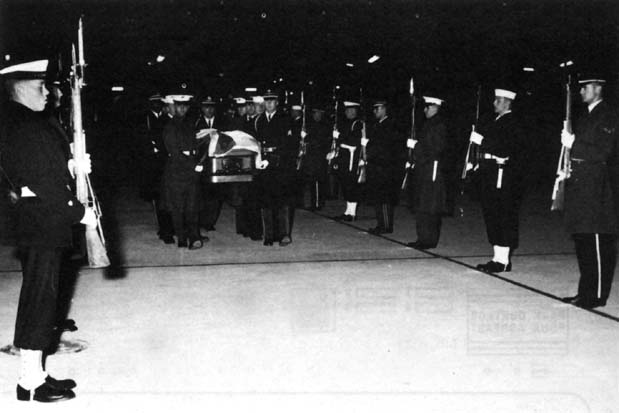
CASKET OF AMBASSADOR DROZNIAK IS CARRIED THROUGH HONOR CORDONS above.
Casket o f Ambassador Drozniak is placed aboard aircraft, below.
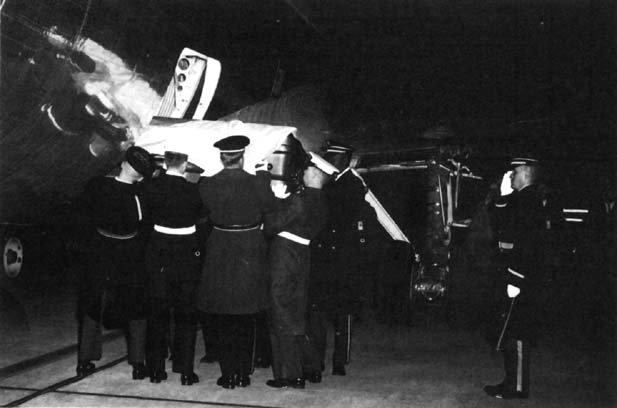
[185]
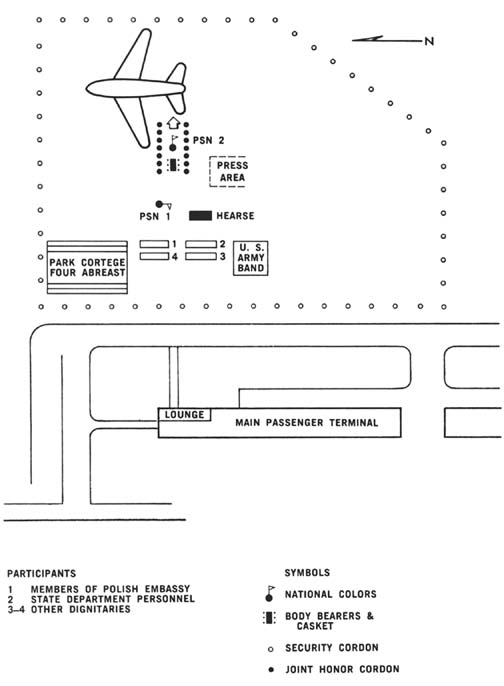
Diagram 53. Departure ceremony, ambassador of Poland, Andrews Air Force
Base.
[186]
the band played, the battery fired nineteen guns, the salute for an ambassador.
After the anthems, the band played Chopin's "Funeral March."
As the march began, the body bearers removed the satin-draped casket from
the hearse. Preceded by the national colors of Poland, the bearers then
carried Ambassador Drozniak's casket through the honor cordon and placed
it on the plane. (Diagram 53) After the casket was aboard the aircraft,
the honor cordon presented arms and the color detail cased the Polish
flag, thus concluding the departure ceremony.
[187]
Previous Chapter
Next Chapter
|





